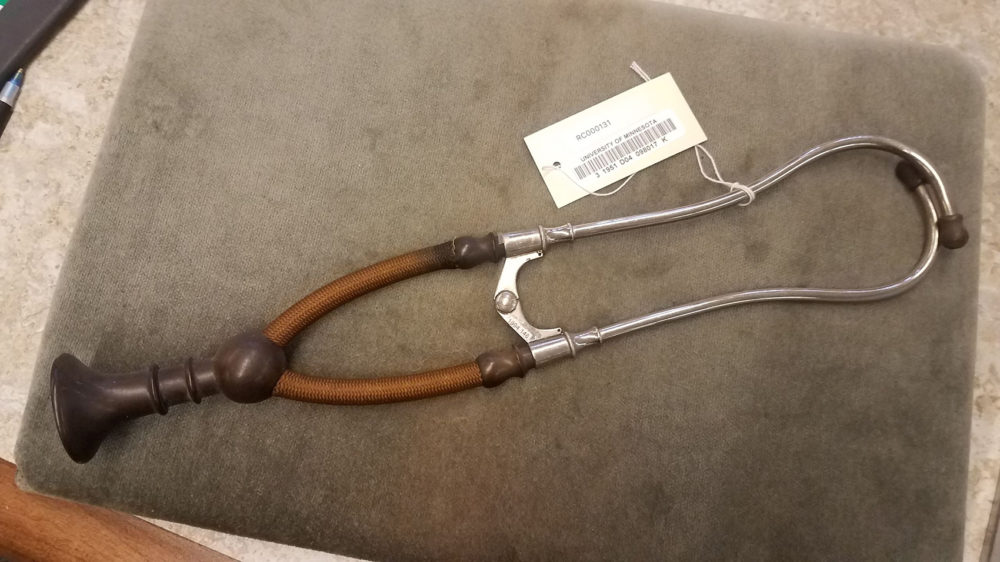Students in Dominique Tobbell’s Technology and Medicine in Modern America class had a unique opportunity to place contemporary issues in medicine and health care in their historical context.
“My course examined how technology came to occupy medicine’s center-stage and what this change has had on health care practices,” said Tobbell.
Adopting an artifact
Early in the semester, Tobbell’s students were introduced to artifacts from the Wangensteen Historical Library of Biology and Medicine which played a central role in the course.
Tobbell explained, “I worked closely with curators Lois Hendrickson and Emily Beck to select artifacts that would help my students explore the history of diagnostic technologies like the x-ray machine and urinalysis, therapeutic technologies such as the pacemaker and prescription drugs, reproductive technologies like contraceptives and prenatal diagnosis, and assistive devices such as prosthetic limbs and hearing aids.”
After adopting an artifact, students dove into the research process using both present-day and primary source materials to discover how their artifact was used in the past and how it has shaped contemporary practice.
“Students were challenged to consider how medical technologies have influenced our ideas about race, gender, and disability,” added Tobbell.
Creating public history
At the end of the course, students wrote a blog post about their artifact. Along the way, they developed research and communication skills while sharing historical insights in ways that are accessible and useful to the public.
In a series of articles, we will showcase the work of Tobbell’s students. First up: an exploration of the stethoscope by U of M College of Liberal Arts student Maria Scanlan.
More than a tool: The history and implications of medicine’s favorite prop
By Maria Scanlan
There are a few things we can always expect at the doctor’s. The sharp smell of recently sterilized rooms, lots of forms, and of course, a physician with a stethoscope draped around their neck. We all know the gasp we let out as the icy bell of the stethoscope presses against our bare backs and chests, and the awkward moments of silence as the doctor solemnly listens to our lungs and hearts.
Is the stethoscope going extinct?
But we may not all know that few doctors know what they’re listening for. Learning to use the stethoscope does require rigorous training, but as few as 20% of recent medical graduates and 40% of family doctors can actually discern the difference between a healthy and a sick heart (1). That’s like only 40% of surgeons knowing how to suture. Not only is there a stark lack of knowledge in using the stethoscope, but using it requires excellent hearing, limiting the discernment of older physicians who simply can’t hear as well as younger ones.
Many would also be surprised to know that an electronic stethoscope that records sound waves on paper, eliminating the need for hearing, was invented in 1926 (2) (It is not commonly used due to its high cost, but it is becoming more cost-effective) (3). With the electronic stethoscope’s implementation and the drawbacks of its predecessor, some argue that the acoustic stethoscope will (and should) go extinct soon (4).
Why we keep the stethoscope
And yet, for better or for worse, doctors are refusing to let go of the simple tool that immediately conveys confidence and know-how. Many doctors admit using a stethoscope is a ritual more than a diagnostic aide, done to instill our trust in them.5 As one doctor wrote in 2016, “the hope that patients continue to look at their doctors with …, makes me hesitant to give up my stethoscope” (5).
Not surprisingly, a study found that the stethoscope is the number one piece of medical technology associated with medicine and with trust in the doctor (6). A quick search of “doctor” yields countless images, all including stethoscopes. So it’s not just doctors protecting the stethoscope’s status — it’s us too.
The stethoscope’s beginnings
The mighty stethoscope had humble origins, however. In 1819, French physician Rene Laënnec wanted an alternative to pressing his ear to a patient’s chest, particularly if the patient were a woman. He found inspiration from children playing with a beam, scratching one end to hear the transmittance at the other. He picked up a piece of paper, rolled it into a tube, and discovered that a similar transmission effect was possible, creating the first basic stethoscope (7). Almost instantly, it was lauded as a revolutionary invention.8
By the early 1900s, the stethoscope we know today was a doctor’s bag staple, indicating commitment to science-based medicine, sterilized instruments, and efficiency in diagnosis (8,9).

Early 1900s model of a binaural (two-ear-piece) stethoscope, made of rubber, nylon, metal, and bronze from the Wangensteen Historical Library.
Stethoscopes allow for simultaneous distance and closeness
And so, the stethoscope became the first piece of medical technology that allowed the physician to non-invasively explore the insides of the human body while simultaneously allowing for distance between the doctor and patient. This trait of the stethoscope set the stage for other medical technology, like the X-ray, which did the same, effectively depersonalizing the physical exam.
But with the evolution of medicine, the stethoscope came to be preferred by patients over other diagnostic technologies. In one 1940 column, a doctor responds to a reader’s question regarding “The Doctor of the Future,” who would have no physical contact with the patient, rather examining them through machines. The reader asks whether this future is near.
The physician responds that “95% of all valuable information … comes from talking with the patient and examining with the eyes and hands and stethoscope.” He emphasizes his distaste for the laboratory physicians of the new age of medicine with a patient’s quote, “I hope you will look less at the X-ray picture and more at me” (10). So, the stethoscope was seen as a vital part of the physical exam, and although it was an instrument, it was still more personal than the X-ray.
What a stethoscope really means
The stethoscope, like all technology, is more than just the instrument and the purpose it serves. A technology is a symbol, and it conveys meaning through not only its usage, but through its context. The stethoscope signifies scientific knowledge, conveys professionalism, and instills trust. When we see the stethoscope, it means that the wearer can discern something that we, even as owners of our own bodies, cannot know. Thus, it is a fundamental prop in sustaining the power dynamic that makes us listen to doctors.
Considering the history and ritualistic value of the stethoscope is critical in analyzing today’s conversations on medicine’s usage of technology with electronic health records, monitors, and now robot-assisted surgery. The future of medicine is here. It’s time to ask ourselves what we want it to look like.
About the author
 My name is Maria Scanlan (she/her/hers), and I am a pre-med, third year in the U of M College of Liberal Arts majoring in Biology, Society, and Environment with minors in Public Health and Spanish. I loved this course, and it was crucial to shaping my understanding of the history of my future profession, teaching me that no technology exists outside of context. It was an awe-inspiring and humbling experience to get to hold hundred year old artifacts that shaped the medical technology we use today, and that I will hopefully learn to use one day as a physician.
My name is Maria Scanlan (she/her/hers), and I am a pre-med, third year in the U of M College of Liberal Arts majoring in Biology, Society, and Environment with minors in Public Health and Spanish. I loved this course, and it was crucial to shaping my understanding of the history of my future profession, teaching me that no technology exists outside of context. It was an awe-inspiring and humbling experience to get to hold hundred year old artifacts that shaped the medical technology we use today, and that I will hopefully learn to use one day as a physician.
Works cited
- Healy, Melissa. “Nice Stethoscope. Now, Learn to use it; Many Doctors Haven’t Mastered the Symbol of their Profession, Medical Veterans Say.: HOME EDITION].” Los Angeles Times, Jan 30, 2006. http://login.ezproxy.lib.umn.edu/login?url=https://search-proquest-com.ezp1.lib.umn.edu/docview/422058624?accountid=14586.
- “Making Heart Throbs Tell the Secrets of Disease.” The Minneapolis Morning Tribune (1909-1930), Mar 7, 1926. http://login.ezproxy.lib.umn.edu/login?url=https://search-proquest-com.ezp3.lib.umn.edu/docview/1846283894?accountid=14586.
- Tanner, Lindsey. “Is the Stethoscope Dying? High-Tech Rivals Pose a Threat to the Symbol of the Medical Profession.” TIME Magazine, October 23, 2019. https://time.com/5707962/stethoscope-doctors-technology/.
- Krumholz, Harlan. “It’s Time to Get Rid of the Stethoscope.” The Wall Street Journal, May 31, 2018. https://blogs.wsj.com/experts/2018/05/31/its-time-to-get-rid-of-the-stethoscope/.
- Bomback, Andrew. “Why Doctors Still Need Stethoscopes.” The Atlantic. Atlantic Media Company, June 24, 2016. https://www.theatlantic.com/health/archive/2016/05/why-doctors-still-need-stethoscopes/481998/.
- Jiwa, Moyez, Stephan Millett, Xingqiong Meng, and Vivien M. Hewitt. “Impact of the presence of medical equipment in images on viewers’ perceptions of the trustworthiness of an individual on-screen.” Journal of Medical Internet Research 14, no. 4 (2012): e100.
- “Laënnec and the Stethoscope.” Journal of the American Medical Association 73, no. 6 (1919): 422- 423. doi:https://doi-org.ezp3.lib.umn.edu/10.1001/jama.2018.1545.
- Stokes, William. An Introduction to the use of the Stethoscope; with its application to the diagnosis in diseases of the thoracic viscera, etc, v-xiii. Edinburgh: A. Balfour & Co., 1825.
- Singer, J. J. “A New Simple Stethoscope.” Journal of the American Medical Association 63, no. 6 (1914): 482-483.
- Clendening, Logan. “Personal Test Still is Best for Diagnosis: Examining with Eyes, Hands, Stethoscope Called most Accurate.” The Washington Post (1923-1954), Jun 17, 1940. http://login.ezproxy.lib.umn.edu/login?url=https://search-proquest-com.ezp3.lib.umn.edu/docview/151283020?accountid=14586.




